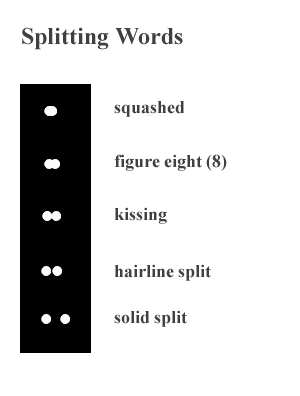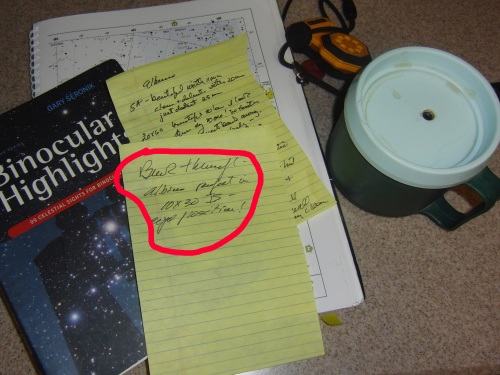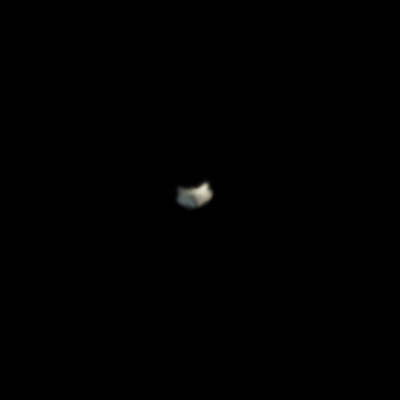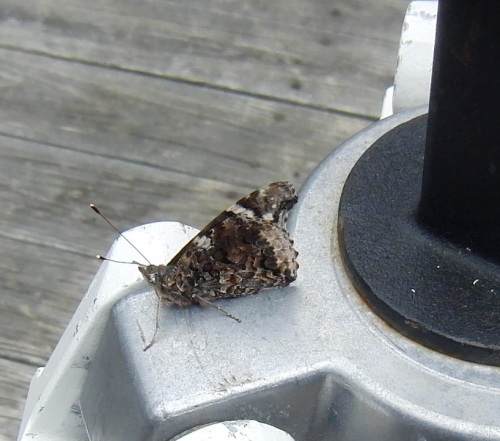
Binoculars set up in Observing Shelter awaiting darkness for testing with doubles - and really testing me more than the binoculars. Unitron is there to check seeing conditions and acts as control of sorts - so to the Sparrow Hawk. (Click image for larger view.)
Until the past week I have never seen really sharp stars in binoculars – and what’s more, I assumed that was normal – that what I wasn’t seeing, others were not seeing.
Wrong!
Maybe decades worth of wrong. How many decades? I’m not sure simply because it’s been relatively recently that I made a serious attempt to see double stars with binoculars and splitting close doubles is the most demanding resolution task of both the instrument and the observer.
From my experience I’ve developed some basic guidelines for splitting doubles with binoculars. They are:
1. Wear your glasses if you have astigmatism – otherwise do without
2. Sit down – or better, lie back in a lawn chair – you must be comfortable
3. Hold the binoculars steady – even 7X50s will benefit from being on a tripod, or parallelogram mount unless, of course, they are image stabilized types
4. Focus carefully – very carefully – first the left eye with center focus, then do the diopter adjustment for the right eye while keeping the left eye closed
5. Spend time on target – Look for at least one solid minute – don’t expect instant success.
6. Relax your eyes – let them focus at a distance and get used to it
7. And if all else fails, maybe you have a problem similar to mine – back off from the eyepieces an inch or two, move your head about some – find the correct head position – the one that works and yields sharp stars.
What follows is all about my own special case of “if all else fails” – because believe me, points one through six didn’t make a difference for me until I could settle the issue of point 7 and right now I’m not sure how many others have a similar problem, but I think it’s relatively few.
OK – the point is, I have been happily using binoculars for years without realizing I wasn’t getting the most out of these instruments – not even close to the most. Oh, I’ve seen galaxies out to 50 million light years or more – and I’ve gotten all sorts of expansive views of star clusters and nebulae. But I suspect what I discovered a few days ago may actually enhance viewing of those objects as well. What did I discover? That binoculars can, indeed, deliver “refractor-like” images of double stars. Let me be as clear as I can about this.
Double stars s hould look like the stars in the images to the right. That is, they should look like nice round discs with clean edges. Now any star that is low in the sky is likely to throw out spikes of light, change colors, and dance about in any instrument just because in that instance you are looking through an awful lot of moving air.
hould look like the stars in the images to the right. That is, they should look like nice round discs with clean edges. Now any star that is low in the sky is likely to throw out spikes of light, change colors, and dance about in any instrument just because in that instance you are looking through an awful lot of moving air.
But, if they are overhead or roughy 45 degrees or higher – and the air is average steady, then you should see nice sharp images when your instrument – binocular or telescope – is properly focused.
I do with telescopes – I don’t with binoculars – or didn’t up until recently and still don’t unless I am especially careful. Is this my special problem? It may be. I have evidence there are some others who share it, but I suspect most people see the sharp stars they should, assuming their binoculars are held very steady – or are of the image stabilized variety – and they have been focused well.
Now let me emphasize that telescopes give me no problem – I can always see sharp, clean images with telescopes when seeing conditions are good. And while I am most likely to see the best images of doubles with either a long focal length refractor, or an apocromatic refractor, I get good, clean star images with any well-adjusted telescope of any design. Not so with binoculars. There the images have been consistently poor for me and I’m still not sure why. but lately I’ve come to suspect that my head simply isn’t screwed on straight – something critics have been telling me for years 😉
Determining what to expect with binoculars – that is, which doubles will split with binoculars – is much different than with telescopes. Double star fans know that all doubles aren’t created equal – and that the main problem is how far apart they are in angular measure – usually stated in seconds of arc. A typical binocular has a field of view of between 2 and 8 degrees depending on how powerful it is. A typical binocular double is separated by less than one minute of arc. So when we are talking about stars separated by, say 30 seconds of arc, we’re talking about a distance that is just 1/120th of a degree. If your binoculars show a six degree field, then this pair of stars is taking up about 1/700th of that field of view. Darned little.
So you also typically put the pair of stars in the middle of your field of view and the middle of the field of view is where even poor quality binoculars tend to perform quite well. Stars half way out to the edges may start to deform and stretch, but in the center they are sharp. That’s why I say – and my experience confirms – that quite inexpensive binoculars can perform reasonably well when splitting doubles.
That is the first piece of big news I pulled out of my recent Eureka Moment.
The second was a handy rule of thumb I stumbled across when researching this subject trying to figure out what the heck was wrong with me. Telescope resolution – or expectations of resolution – are typically guided by something called the Dawes Limit which is entirely dependent upon the size of the objective – a bigger objective creates smaller star images (in terms of angular size) and will thus split stars that are closer together – it’s as simple as that. Now double star observers no it’s not really that simple – that frequently when the pair of stars have one that is much dimmer than the other, this rule crumbles because the dimmer star gets lost in the glare of the brighter one.
But if we are talking about stars that are within a couple of magnitudes of one another in brightness, the Dawes limit is a good starting point for determining how close stars can be and still be split. The problem is, this rule assumes you are using fairly high magnification – say 30 times your objective diameter in inches. With binoculars you are almost always using much lower magnification. For example, my 10X30 image stabilized binoculars deliver only about eight times the objective diameter in inches. And my 25X100 binoculars have a power just four times the objective diameter in inches.
But Gary Seronik, in his small book “Binocular Highlights” suggests another rule of thumb that applies to binoculars – simply divide the power of your binoculars into 300. The answer is the separation, in seconds of arc, that those binoculars should be able to split. Thus my 10X30 binoculars – or 10X50 – should be able to split two stars that are separated by 30 seconds of arc. Albireo, a very popular double, is separated by 34 seconds of arc, so the 10X glasses should split it. My 25X100 should be able to split stars that are 12 seconds of arc apart – that means the very popular double Mizar – which is separated by about 14 seconds – should split in the 25X binocular – and, indeed, it does. However, my 20X glasses will probably have problems with it – 300/20=15 – and they do, though I have been able to split Mizar with those glasses, it’s difficult. So I think this is an excellent – though rough – guide. (The Dawes limit on those 25X100 binoculars, btw, is barely a second of arc – but that is a totally unrealistic expectation for binocular performance. Dawes limit = 4.56 Arc Seconds / Objective Diameter (inches) so 4.56/4 = 1.14. In fact, it is rare for a telescope to achieve this resolution on a double, but something like 1.8″ of arc is a reasonable expectation for a 4-inch t eleescope.)
But these numbers have not mattered much to me when using binoculars. I have only split the widest doubles. So, for example, over the years I really needed 15X binoculars to get a good, obvious split of the Dragon’s Eyes – Nu Draconis – a charming pair of 5th magnitude stars a wide 60 seconds of arc apart. Now, the new me finds them simple with just 10X30 binoculars. Fifteen power glasses should, by this rule, be able to split stars just 20 seconds apart. The Dragon’s eyes should fall to binoculars as low as five power! What’s more, in the past when I split this pair I didn’t get the kind of clean, “bullet hole”, stars shown in the image – I got dancing stars – bloated, jiggly stars throwing out spokes of light. It’s just that the 15 power binoculars – and the wide split – made it possible for me to see this pair as two stars – and I assumed everyone was seeing the same thing.
But I was puzzled how observers I respect and admire like Seronik and Ed Zarenski, to mention just two, routinely split stars that were far, far closer together and instead of bragging about their amazing eyes and observing skills, seemed to think that others could routinely do the same. I know I couldn’t.
It must be my eyes. They must have problems I’m not aware of. That was my first train of thought and I’ve been pursuing that one for the better part of a year – without staisfaction. And a recent trip to the eye doctor confirms my practical experience – there’s nothing seriously wrong with my eyes. In fact, I have what the doctor describes as a “slight astigmatism” – so slight that they say that if I get corrective glasses I will barely notice the difference – and though this doctor worked with folks who sold glasses, she didn’t recommend them for me. (I ordered them anyway – there was a special on where they’ll cost just $50 and this is something i have to see for myself because this whole business is driving me more than a little crazy.)
The Breakthrough
My breakthough came on a morning when I had decided to test five different binoculars – 10X30IS Canons, 15X70 Celestron Skymasters, 20X60 Pentax, 20X80 Celestrons, and 25X100 Zhummels. With the exception of the image stabilized Canons, all would be tested mounted on one of two parallogram mounts. The largest of these mounts was on a pier and really too tall for me to use sitting down, so I was using that one standing. As a way to check the seeing and to make sure I could actually split these particular stars at low power, I had two small refractors set up as well – a 60mm Unitron using a 40mm Kellner eyepiece for roughly 24X and a 50mm Stellarvue Sparrow Hawk that was a lot like a single binocular in that it used a prism diagonal and was of very short focal ratio – F4.1. I used a 20mm eyepiece in this to get 10X, so it was, in many ways, a good match for the Canon 10X30IS.
My targets were the doubles Albireo (34.4″), Zeta Lyra (44″), Nu Draconis -Dragon’s Eyes– (62″), and Mizar (14.3″) – all were at a good altitude on this spring morning.
Initial tests
And the notes from my initial test showed nothing went particularly well at first. This was the old me.
Actually, I started in the early evening with Mintaka – a wide split at 52.8″ of arc that should be easy with all the binoculars I was testing, except there also is quite a difference in magnitude – 2.4, 6.8. That 4.5 magnitude difference makes Mintaka a bit of a challenge. But the 25X100s showed it well. The 20X80s gave me a good look, though not quite as good as the larger binoculars. Actually, the best view came with the 20X60s – not sure why, but this is the old me talking. I’m seeing a split, but the primary is shooting fire. The 10X30IS gave me an occasional glimpse. The best view came with the Unitron with the 40mm Kellner, so this was roughly comparable to the 20X60 binoculars, but the star images were much better. I assumed that was because it was a long focal length refractor – and that probably was part of the reason, but as I later learned, didn’t account for all the difference.
The point here is that even the old me could split some doubles – just not nearly as well as I later learned was possible.
I moved on to the much more challenging Mizar. The 10X30IS couldn’t split it – no surprise. The separation is too little for those binoculars. Here I drew a quick sketch of what I saw with the 20X60s because the stars were so bloated and dancing so much I couldn’t be sure I was seeing a split, but I thought I was. When I checked with the 60mmUnitron I was sure – the binocular view was correct – but, there was absolutely no comparing the two views. The Unitron – at roughly the same power- was far, far cleaner than the binoculars. (Remember, at 20X you should barely be able to split Mizar – the formula says 15″ is the minimum separation. Mizar is 14.3″ – though the stars are fairly close in magnitude – 2.2 and 3.9.) The 25X100 gave me a certain split, but certainly NOT “refractor-like” stars.
But something strange was starting to happen. As I maneuverd the binoculars on the parallelogram mounts they were sometimes a few inches from my eyes and once in a while I got a glimpse of sharp stars such as I saw in the Unitron. This first happened with the 20X80 Celestrons and it came when I seemed to bend my head back and literally look down my nose from an inch or two behind the eyepieces. I was tired. I was getting cold. And I really didn’t know what was going on, so I went in with the intention of getting four hours sleep and trying again when I was refreshed.
Morning session

Field notes on Albireo - at last, a clear view.
Nothing comes easily to me – especially in terms of binoculars. I wrestle with mounts, I fiddle endlessly with focus, and mostly I have ended end up seeing something like this:

I have a sense of two stars here, of course, but theimages are dancing, the colors swapping sides, and sometimes I think I see the secondary in one place, sometimes in another.
When I should see – and now do see – this:

What a delight! This is what I'm used to seeing with a telescope and now - with more and more consistency and less and less hassle, can see with binoculars.
In one sense the change was nearly instantaneous – that is, I would go from a terrible image to a perfect one – no inbetween. But it only happened after a lot of work and a lot of false steps.
What made me put in the extra effort was I justc ouldn’t reconcile the diffferent experience of using two very nice instruments on Albireo. The first was the Stellarvue Sparrow Hawk aka Little Rascal. This is a 50mm finder, essentially, but it takes standard eyepieces and is easy to focus. But like a binocular it has a very short focal ratio – F4.1 – and it uses a prism to deliver an erect image. And as my notes show, when I pointed it at Albireo on this particular morning with a 20mm eyepiece (10X) I got a “clean and delicate” split just as I would expect with any telescope – though this wasn’t any telescope. this was essentially half a binocular.
Then when I switched to the 10X30IS Canon’s I was back in Blursville with dancing stars. And then I started to notice something. I noticed it with the large, mounted binos – the 25X100 Zhummel and the 20X60 Pentax, and 20X80 Celestrons. If I backed my eye way off – I’m talking two or three inches from the eyepieces – and tilted my head so I was in effect looking down my nose there were long moments when the two stars snapped into sharp focus. Crazy? I’m not sure. When Ibrought this up in a Cloudy Nights discussion forum a few people came forward to talk of similar experiences – but on a few.
Believe me , my heart was racing. I have looked at countless double with binoculars and I had never seen them like this. This was a real breakthrough and I quickly skipped about from Albireo to Zeta Lyre, to the Dragon’s Eyes and then to Mizar. With these kargerf binoculars everything was great – really great with the bright image sof the 25X100,
I couldn’t believe my luck. I hadn’t even brought out the 10X30IS for this session because I had about given up on them. Twilight was starting to grow brighter in the east. I quickly went back to the house, got the 10X30IS, and voila! There was a perfect Albireo – a yellow star with a scrumptious blue pinpoint right next to it. I simply couldn’t believe it. It was every bit as good as I had seen in the tiny Sparrow Hawk refractor. The only question that remains is why the heck did it take me half a century of observing to discover this?
Well, not the only question. Since this breakthrough I have had three more sessions under the stars and I have expanded the variety of stars I’m looking at to include 16 & 17 Draocnis, Regulus, and Psi Draconis. I have had my eyes examined by a professional and asked her for ane xplanation – why the heck do I have to look down my nose at doubles? And I have discussed it in online forums and with Larry Patriarcha, the guy who makes and sells the best parallelogram mounts I know of. Allt hese people had ideas, but no really firm answers.
But here’s the rub. This is getting easier and easier for me to do – that’s good news, but doesn’t solve the puzzle. I am finding with practice I now achieve this state of double star nirvana without half trying. But it still is easiest to reach if I back off form the eypieces, then, once i get it, approach them slowly being careful to maintain my head position.
So I think it does have something to do with head position – after all, with binoculars you look up – with many telescopes using diagonals you look down. And it may have some tiny thing to do with astigmatism, and it may have to do with stressing my eye muscles by tiltilting my head back and looking down my nose. But two things are clear to me – first, most observers don’t seem to experience this problem. Second, I don’t understand fully why I do, nor do I understand fully the solution because the ground rules seem to be slipping out from under me. There definitely is a groove and I find it easier and easier to get in it. And believe me, I’m not complaining. This opens up a whole new area of especially enjoyable observing for me.
Doubles I love. I always have found a magic in seeing two perect little globes next to one another. But now I can see them with both eyes open and while leaning back in a comfortable lawn chair and looking up at the sky – and that, for me, really is double star nirvana.
Read Full Post »






 hould look like the stars in the images to the right. That is, they should look like nice round discs with clean edges. Now any star that is low in the sky is likely to throw out spikes of light, change colors, and dance about in any instrument just because in that instance you are looking through an awful lot of moving air.
hould look like the stars in the images to the right. That is, they should look like nice round discs with clean edges. Now any star that is low in the sky is likely to throw out spikes of light, change colors, and dance about in any instrument just because in that instance you are looking through an awful lot of moving air.


